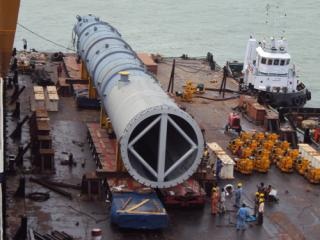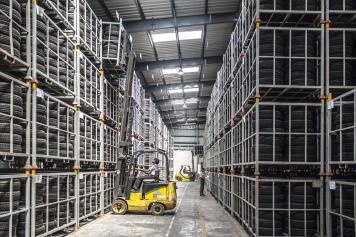General director Tham Tuck Choy revealed there were plans to add two or three more outlets every year, including two in Ha Noi this year, because of the chain’s successful performance.
The hard part for him is to find large spaces in the right places.
The CBD (central business district) saw some major new supply last year with the opening of Vincom Galleries in Ha Noi and Kumho Asiana Plaza in HCM City, both of which were launched with an occupancy rate of more than 80 per cent, according to real-estate service provider CBRE Viet Nam.
In HCM City the vacancy in CBD shopping centres stood at only 0.7 per cent at the end of 2009, by which time the average rent had risen by over 25 per cent to more than US$97 per square metre.
But at Vincom Tower in HCM City’s District 1, which is expected to open in late April, the price has topped $200. It has already leased out 80 per cent of its over 50,000sq.m of retail space.
The Bitexco Financial Tower is also expected to be completed soon in the CBD.
These two buildings will add around 70,000sq.m to the existing 256,000sq.m of retail space at the city’s 22 shopping centres and department stores.
Buildings to open in the city’s other areas include the Lotte Everich and Flemington in District 11 and Crescent Mall in Phu My Hung.
In Ha Noi, the vacancy rate at malls in the CBD is only 0.38 per cent compared to 37 per cent in other areas. The rent ranges from $80 to $146 per square metre.
No major new supply is planned this year in the Ha Noi CBD area.
Singapore-Viet Nam co-operation
During Singaporean Prime Minister Lee Hsien Loong’s visit to Viet Nam last week, several Vietnamese and Singaporean firms entered into partnerships, helping boost bilateral economic ties.
The VSIP Group broke ground on Wednesday for the Viet Nam-Singapore Industrial Park (VSIP) Hai Phong Co Ltd, an integrated township and industrial park in the northern port city.
The $1 billion project will have 1,100ha for commercial and residential development and 500ha for a clean industrial park.
It is expected to have a residential population of 150,000 in 10 years’ time. It will also have a financial centre, schools, shopping malls, hotels and medical clinics.
More than 10 local and foreign investors have committed to spend $300 million to develop a commercial complex, a residential area, a school and manufacturing facilities.
Lee told the ground-breaking ceremony that the VSIP was a concrete symbol of the excellent co-operation between the two countries.
The VSIP Group has two IPs in Binh Duong Province and another in Bac Ninh Province near Ha Noi.
They have attracted a combined investment of more than $2.5 billion and provided 60,000 jobs.
Earlier in the week, Singapore firm CapitaLand (Viet Nam) Holdings signed a joint venture agreement with the Hoang Thanh Investment and Infrastructure Development Joint Stock Company to develop a residential project in the capital’s Ha Dong District.
CapitaLand will hold a 70 per cent stake in the $170 million, 14,000sq.m project.
It is also developing three other residential projects, two in HCM City and one in Ha Noi.
Other companies to enter into tie-ups were Keppel Land and Tien Phuoc, EOC Limited and PetroVietnam Transportation Corp, and United Overseas Bank and the Ha Noi National University. A Singaporean bank, the DBS, also received a licence to operate in Viet Nam.
Singapore is a major source of foreign direct investment for Viet Nam, with more than 470 companies investing a total of over $9 billion.
Insurers look to cheaper products
Trinh Thanh Hoan, head of the Ministry of Finance’s Insurance Administration and Supervision Department, has called on life insurance companies to develop micro-insurance and other products to better tap the market and ensure growth this year.
The ministry has set a life-insurance premium target of VND12.85 trillion ($710 million) for this year, up more than 12 per cent from 2009.
Viet Nam, with a population of more than 85 million, is a promising market for life insurance products since just 5 per cent of the people have insurance now.
With a large portion of the population – more than 60 million – living in rural areas, micro-insurance (whose feature is low premium) will appeal to people with low incomes.
Canada’s Manulife Viet Nam launched micro-insurance products last September with a monthly premium of VND30,000 ($1.67), targeting people in rural areas.
According to general director David Wong, micro-insurance can cover any risk that is insurable, including illness, accidental injury, death and loss of crop.
Last year 11 life insurance companies collected more than VND11.4 trillion in premiums. The UK’s Prudential is said to have topped the list in terms of new premiums, accounting for around 31 per cent. Bao Viet Life, the only domestic company in the life insurance market, followed with a 28 per cent share, and Manulife ranked third, holding 10 per cent.
Two American firms, ACE Life and AIA, each accounted for 9 per cent. — VNS























